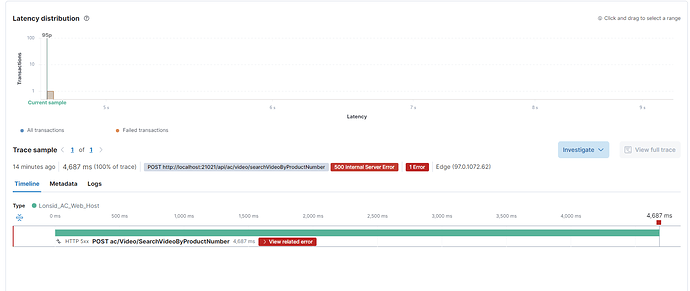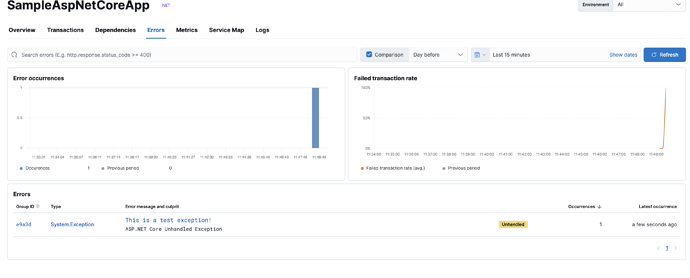I tried to upgrade Elastic.Apm.NetCoreAll to 1.13.0, then started the service and debugged an interface, the service got an error (similar to Elastic.Apm.NetCoreAll compatibility issues), that's not the point.
I am operating the interface "searchVideoByProductNumber", and then there is an error in the dependency package. Why is the http500 error in the interface "searchVideoByProductNumber" recorded? Rather than accurate to the dependency package error?
This is not a very urgent issue, but I am a little interested to know the answer.
Thanks in advance for taking the time to answer me.
2022-01-17 15:11:29 ERROR 3d55b1816bb2a446a848550a29d1a752 154af42ba8fa5346 Method not found: 'Void Elastic.Apm.Api.IExecutionSegment.CaptureException(System.Exception, System.String, Boolean, System.String)'.
System.MissingMethodException: Method not found: 'Void Elastic.Apm.Api.IExecutionSegment.CaptureException(System.Exception, System.String, Boolean, System.String)'.
at Lonsid.APM.LonsidExceptionFilter.<>c__DisplayClass1_0.<HandleAndWrapException>b__0()
at System.Threading.Tasks.Task.InnerInvoke()
at System.Threading.Tasks.Task.<>c.<.cctor>b__274_0(Object obj)
at System.Threading.ExecutionContext.RunFromThreadPoolDispatchLoop(Thread threadPoolThread, ExecutionContext executionContext, ContextCallback callback, Object state)
--- End of stack trace from previous location where exception was thrown ---
at System.Threading.ExecutionContext.RunFromThreadPoolDispatchLoop(Thread threadPoolThread, ExecutionContext executionContext, ContextCallback callback, Object state)
at System.Threading.Tasks.Task.ExecuteWithThreadLocal(Task& currentTaskSlot, Thread threadPoolThread)
--- End of stack trace from previous location where exception was thrown ---
at Lonsid.APM.LonsidExceptionFilter.HandleAndWrapException(ExceptionContext context)
at Lonsid.APM.LonsidExceptionFilter.OnExceptionAsync(ExceptionContext context)
at Microsoft.AspNetCore.Mvc.Infrastructure.ResourceInvoker.<InvokeNextExceptionFilterAsync>g__Awaited|25_0(ResourceInvoker invoker, Task lastTask, State next, Scope scope, Object state, Boolean isCompleted)
2022-01-17 15:11:30 ERROR An unhandled exception has occurred while executing the request.
System.MissingMethodException: Method not found: 'Void Elastic.Apm.Api.IExecutionSegment.CaptureException(System.Exception, System.String, Boolean, System.String)'.
at Lonsid.APM.ExceptionEventHandler.HandleEvent(AbpHandledExceptionData eventData)
--- End of stack trace from previous location where exception was thrown ---
at Abp.Events.Bus.EventBus.Trigger(Type eventType, Object eventSource, IEventData eventData)
at Abp.Events.Bus.EventBus.Trigger[TEventData](Object eventSource, TEventData eventData)
at Abp.AspNetCore.Mvc.ExceptionHandling.AbpExceptionFilter.HandleAndWrapException(ExceptionContext context, WrapResultAttribute wrapResultAttribute)
at Abp.AspNetCore.Mvc.ExceptionHandling.AbpExceptionFilter.OnException(ExceptionContext context)
at Microsoft.AspNetCore.Mvc.Infrastructure.ResourceInvoker.Next(State& next, Scope& scope, Object& state, Boolean& isCompleted)
at Microsoft.AspNetCore.Mvc.Infrastructure.ResourceInvoker.<InvokeNextResourceFilter>g__Awaited|24_0(ResourceInvoker invoker, Task lastTask, State next, Scope scope, Object state, Boolean isCompleted)
at Microsoft.AspNetCore.Mvc.Infrastructure.ResourceInvoker.Rethrow(ResourceExecutedContextSealed context)
at Microsoft.AspNetCore.Mvc.Infrastructure.ResourceInvoker.Next(State& next, Scope& scope, Object& state, Boolean& isCompleted)
at Microsoft.AspNetCore.Mvc.Infrastructure.ResourceInvoker.<InvokeFilterPipelineAsync>g__Awaited|19_0(ResourceInvoker invoker, Task lastTask, State next, Scope scope, Object state, Boolean isCompleted)
at Microsoft.AspNetCore.Mvc.Infrastructure.ResourceInvoker.<InvokeAsync>g__Logged|17_1(ResourceInvoker invoker)
at Microsoft.AspNetCore.Routing.EndpointMiddleware.<Invoke>g__AwaitRequestTask|6_0(Endpoint endpoint, Task requestTask, ILogger logger)
at Elastic.Apm.AspNetCore.ApmMiddleware.InvokeAsync(HttpContext context)
at Lonsid.Runtime.Session.PSSO.LonsidPSSOMiddleware.Invoke(HttpContext context)
at Lonsid.AC.Authentication.JwtBearer.JwtTokenMiddleware.<>c__DisplayClass0_0.<<UseJwtTokenMiddleware>b__0>d.MoveNext() in C:\Users\wwx\Desktop\lonsid\Lonsid.AC\Lonsid.AC.Web.Core\Authentication\JwtBearer\JwtTokenMiddleware.cs:line 22
--- End of stack trace from previous location where exception was thrown ---
at Microsoft.AspNetCore.Authentication.AuthenticationMiddleware.Invoke(HttpContext context)
at Microsoft.AspNetCore.Diagnostics.DeveloperExceptionPageMiddleware.Invoke(HttpContext context)


